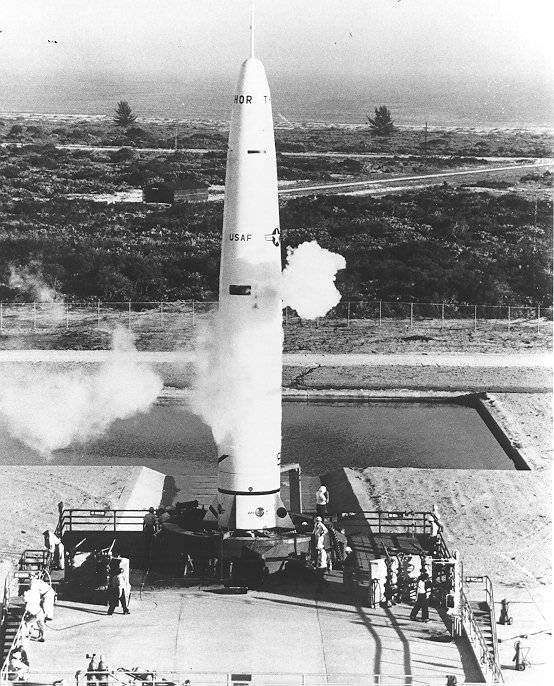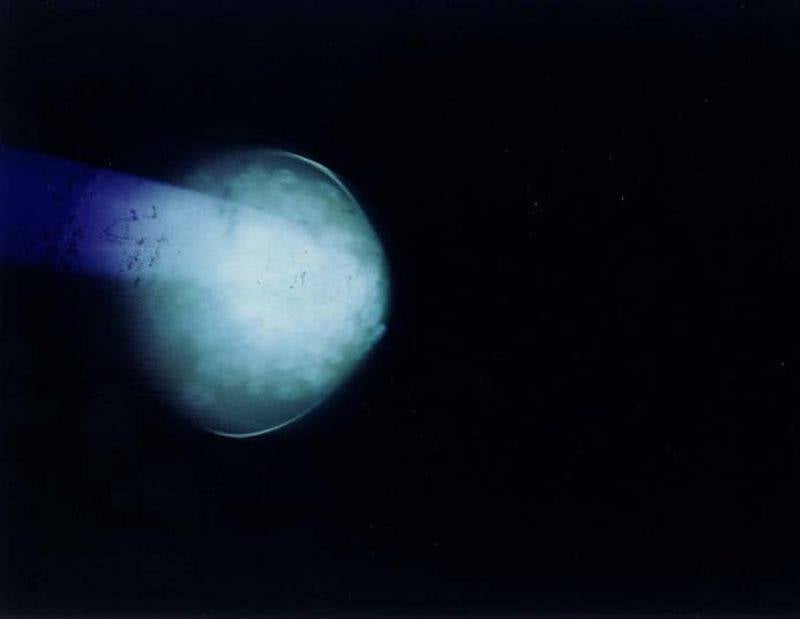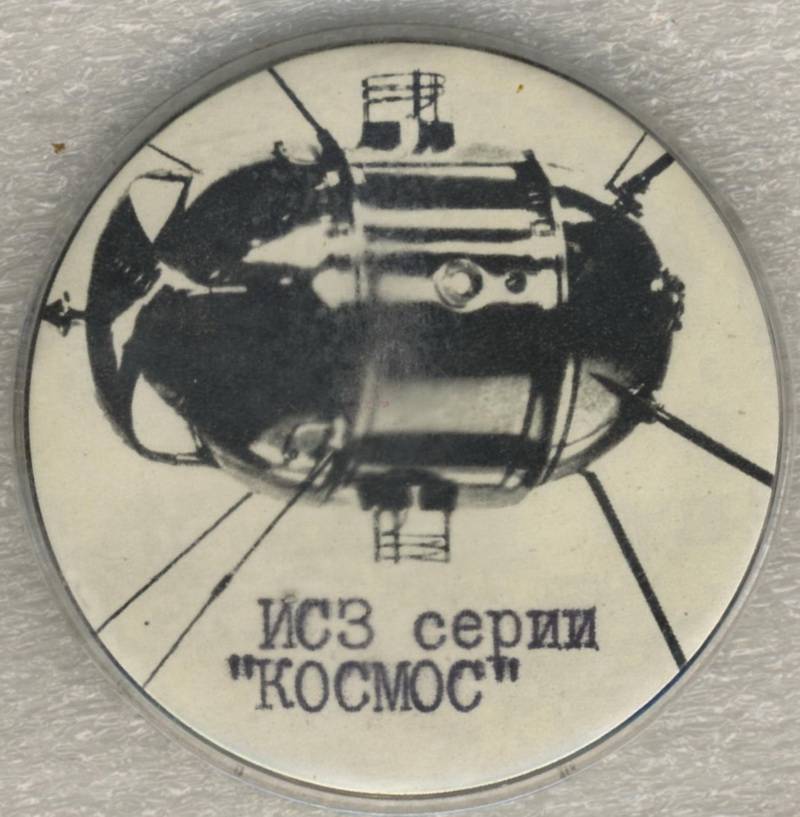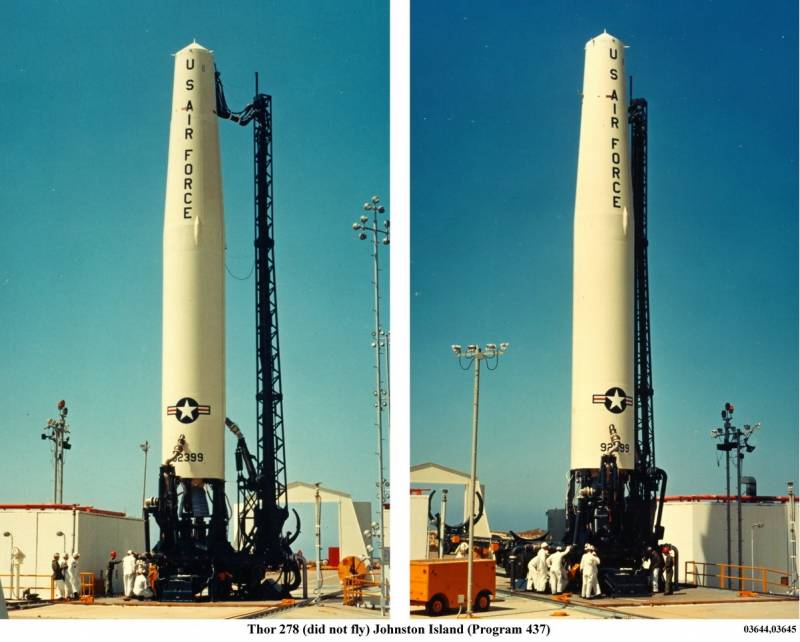How the Americans shot down a Soviet satellite
According to The National Interest, the victims of American anti-satellite missiles based on the PGM-17 Thor medium-range ballistic missile were at least 6 satellites: Traac, Transit 4B, Injun I, Telstar I, and the British satellite Ariel I Soviet satellite "Cosmos-5". All listed satellites suffered from Starfish Prime tests. In this case, the greatest resonance in those years caused the failure of the Telstar I satellite, which was responsible for the transmission of television pictures between the United States and Europe. It is believed that this satellite was the victim of US conducted nuclear tests in space. 21 February 1963, this space satellite is completely out of order.
It should be noted that in the USA, projects on the possible destruction of satellites in near-earth orbit started already in 1957 and were directly connected with the successful launch of the USSR by the first artificial Earth satellite, Sputnik-1. The first attempts to destroy the satellite with a rocket launched from the aircraft were made by the US military in the second half of the 1959 year. On September 3, a rocket was launched from the B-58 aircraft, the target of which was the Discoverer 5 satellite. This launch was an emergency. October 13 1959 rocket "Bold Orion", which was launched from the B-47 bomber, passed just 6,4 kilometers from the Explorer 6 satellite at an altitude of 251 kilometer. This launch of the US military recognized successful.
It should be noted that the Soviet Union did not stand by and also developed its own programs in the field of anti-satellite weapons. Work on the creation of such systems in the USSR started at the beginning of the 1960-ies, when it finally became clear that not only rockets flying from space, but also reconnaissance, navigation, meteorological satellites and satellites communications, which are full-fledged military facilities, the destruction of which became justified in the event of the start of full-scale hostilities.

But at the same time, the United States went much further in this matter, having considered the possibility of destroying the enemy satellites with the help of full-fledged ballistic missiles equipped with thermonuclear warheads. A similar rocket was created and tested by the United States already in 1962, as part of the Dominic project, when in a short time from 1962 to 1963, the Americans conducted a series of nuclear tests, which consisted of 105 explosions. Including a series of high-altitude nuclear tests in the framework of the project under the code “Operation Fishbow”. It was within this project that the Thor anti-satellite rocket was tested, which successfully detonated thermonuclear munition in near-earth space at an altitude of about 400 kilometers.
The Dominic project was carried out at the time of the greatest aggravation of relations between the United States and the USSR. The aggravation of relations even before the famous “Caribbean crisis” was promoted by the American administration’s attempt to overthrow the government of Fidel Castro in Cuba. To this end, in April 1961, the United States conducted an operation in the Bay of Pigs. In response to this 30 August 1961, Nikita Khrushchev announced the termination of a three-year moratorium on testing nuclear weapons. A new round of the arms race has begun, in the United States, John Kennedy authorized the conduct of Operation Dominic, which entered forever in historyas the largest nuclear testing program ever conducted in the United States.
The “437 program” was initiated by the US Air Force in February 1962, it was approved by US Secretary of Defense Robert McNamara. The program was aimed at developing weapons capable of dealing with the enemy's space objects. The development of cosmonautics has turned orbital observation and communication satellites into strategic military facilities that could have a significant impact on the course of military operations. Under these conditions, the means of dealing with them became increasingly important on both sides of the Atlantic.

The Americans viewed the Thor missile as a means of anti-satellite warfare. PGM-17 Thor is the first medium-range ballistic missile that was put into service in the US in the 1958 year. It was a single-stage liquid-propellant rocket, whose engine worked on kerosene and liquid oxygen. The cylindrical body of the rocket narrowed sufficiently smoothly towards the top, which gave the Torah, according to staff reviews, a resemblance to a milk bottle. The medium-range ballistic missile PGM-17 Thor had a launch mass of 49,8 tons and a maximum range of 2400 km. To protect against adverse weather conditions, the rocket had to be stored in a horizontal position in special unfortified ground shelters. Before launching the rocket was raised to a vertical position and refueled. Total rocket preparation time for launch was about 10 minutes.
As part of the implementation of the "437 Program" rocket "Thor" was considered as a means of destroying various space objects. At the same time, the rocket differed in a rather powerful warhead - 1,44 megatons. As part of a test called Starfish, the initial launch of the “anti-satellite” Thor missile was to occur on 20 June 1962. However, just a minute after the launch, the malfunction of the rocket engine led to the loss of the rocket and the nuclear device. In this case, the wreckage of the rocket and the resulting radioactive debris fell on the Johnston Atoll and led to radiation contamination of the area.
The second attempt was scheduled for July 9 1962, she was successful. Launched with the help of a Thor missile, a nuclear warhead with a 49 X-load of megatons of W1,44 exploded at an altitude of 400 kilometers in near-earth space above the Johnston Atoll located in the Pacific Ocean. The almost complete absence of air at a given height prevented the formation of a cloud familiar to us in the form of a nuclear mushroom. In this case, with such a high-altitude explosion, other interesting effects were recorded. At a distance of about 1500 kilometers from the explosion - in Hawaii, under the influence of the strongest electromagnetic impulse, televisions, radios, three hundred street lamps and other electrical appliances failed. At the same time in the sky throughout the region for more than 7 minutes it was possible to observe a bright glow. He was seen and captured on film from Samoa, which was located at a distance of 3200 kilometers from the epicenter of the explosion.

The charged particles formed as a result of a nuclear explosion were picked up by the Earth's magnetosphere, as a result of which their concentration in the radiation belt of the planet increased by 2-3 order. The impact of the radiation belt led to a very rapid degradation of the electronics and solar cells of several artificial earth satellites, among which was the first commercial American telecommunications satellite Telstar 1. It was launched the day after the nuclear test - July 10. It is believed that he was fully affected by their consequences. He stopped his work already in December of 1962, in early January his work was restored, however, the 21 of February of the same year, the satellite finally failed, remaining in Earth orbit. At the same time, in the Pentagon, the information that a high-altitude nuclear explosion could disable space objects was received with enthusiasm, since the United States had a way to destroy Soviet satellites.
As noted in the edition of The National Interest, one of the victims of the American Thor rocket was the satellite Cosmos-5. This Soviet research satellite, belonging to the Cosmos series of space vehicles, was launched on May 28 1962 from the Kapustin Yar cosmodrome from the Mayak-2 launch complex using the Kosmos 63-X1 launch vehicle. An equipment was installed onboard the satellite to study the radiation situation in near-Earth space, as well as to study the aurora and to obtain information on the ionospheric formation processes. The Americans believe that this satellite was another victim of the test of the Thor rocket in near-Earth space, having experienced the same problems as the Telstar I telecommunications satellite. The Kosmos 5 satellite ceased to exist 2 in May 1963.
In the 1964, the anti-satellite system based on a Thor ballistic missile with a thermonuclear warhead was officially adopted under the symbol PGM-17A (the intended renaming to PIM-17A was not officially approved for an unknown reason). The first rockets went on combat duty in August 1964 of the year. These missiles were able to intercept any orbital object located at an altitude of 1400 kilometers and at a distance of 2400 kilometers. The radius of destruction in the explosion of a megaton warhead guaranteed the instantaneous destruction of artificial satellites by thermal and radiation effects at a distance of 8 kilometers from the epicenter of the explosion. The US Air Force Base Vandenberg in California and the Johnston Atoll in the Pacific Ocean west of the Hawaiian Islands were used as launch pads. Especially for the control of anti-satellite missiles and a series of non-nuclear tests in the US Air Force, the 10-th Aerospace Defense Division was formed. Despite the fact that the Americans were convinced that heavy nuclear warheads were not the best means of dealing with low-orbit satellites, Thor missiles on the Johnston Atoll remained on duty in constant readiness for launching until the 1975 year.
It is clear that a number of circumstances, including risk, hindered the development of the 437 Program. The United States was well aware that a nuclear attack on satellites could be perceived by the Soviet Union as the beginning of hostilities, which would entail a retaliatory strike from Moscow. There has also always been a risk that such an attack, if it does not cause the onset of a total nuclear war, will lead to unintended consequences, that is, the accidental destruction or temporary decommissioning of Allied satellites, as happened during the Starfish Prime tests. The depreciation of the missiles themselves, which have reached the end of their service life, also played a role in closing the program. An important role was played by the lack of funding, at that time a huge part of the US military budget went to the war in Vietnam. Therefore, in 1975, the Pentagon finally closed the “437 Program”. The fact that 5 August 1963 was also played by the USSR, the USA and the United Kingdom signed a joint treaty banning nuclear weapons tests in the atmosphere, outer space and under water played its part.
In this case, the development of non-nuclear anti-satellite systems, no one refused. So in the US, in the 1977-1988 years, work was actively carried out under the ASAT program (an abbreviation of AntiSatellite). Work was underway to create a new generation of anti-satellite weapons based on a kinetic interceptor and carrier aircraft. In the 1984-1985 years, flight tests of an airborne anti-satellite missile took place: of the five launches carried out at that time, only in one case did the interceptor missile hit the space target. However, this is a completely different story.
Information sources:
https://nationalinterest.org/blog/buzz/how-america-planned-win-war-against-russia-nuke-satellites-25471
https://vseonauke.com/1399178607284193321/10-beznadezhnyh-popytok-zavoevat-vneshnee-kosmicheskoe-prostranstvo
https://ria.ru/spravka/20141013/1028053411.html
Open source materials

Information